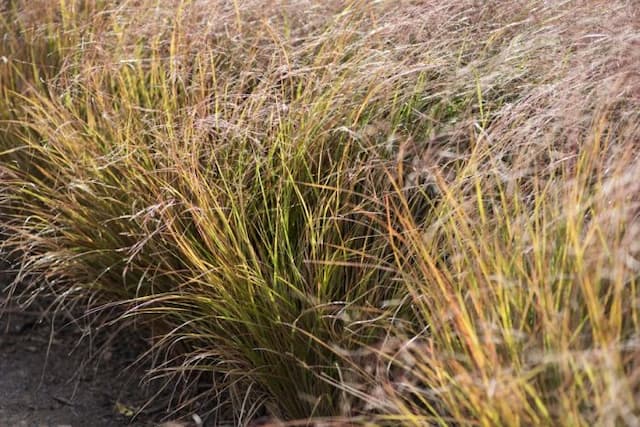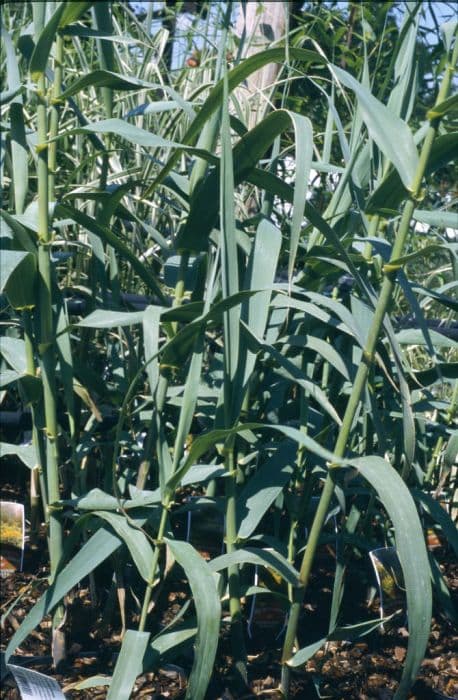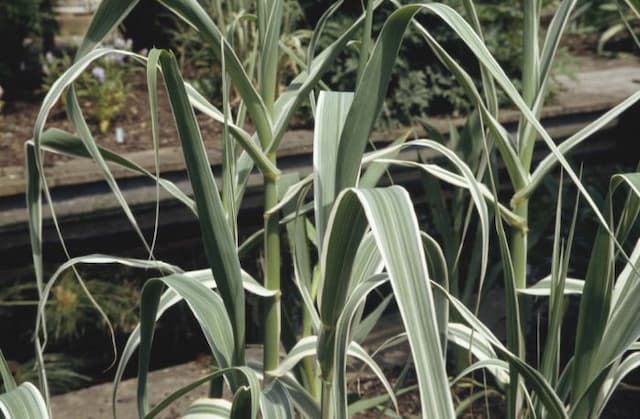Switchgrass Panicum virgatum 'Prairie Sky'











ABOUT
The plant known as 'Prairie Sky' is a variety of switchgrass that possesses a lush and upright growth habit. This perennial grass is characterized by its narrow, blue-green leaves that form dense, upright clumps, presenting an elegant and feathery texture. It is noteworthy for its rich coloration that lasts throughout the growing season. In summer, airy panicles of tiny flowers emerge, held above the foliage on slender stems. These inflorescences contribute to a light and breezy feel while adding visual interest to the garden. As the seasons progress, the leaves may transform into hues that offer warm tones, providing an eye-catching display even as the temperature drops. The seed heads too mature, turning into a buffet for birds and adding a delightful rustling sound when caught by the breeze. 'Prairie Sky' switchgrass imbues a natural and wild aesthetic to landscape designs with its graceful form and movement, evoking the open charm of prairie landscapes.
About this plant
 Names
NamesFamily
Poaceae
Synonyms
Switchgrass, Tall Panicgrass, Wild Redtop, Thatchgrass
Common names
Panicum virgatum.
 Toxicity
ToxicityTo humans
Switchgrass is generally not considered toxic to humans. However, like many plants, it could cause mild stomach upset if ingested in large quantities. It is not associated with severe toxicity or poisoning symptoms in humans.
To pets
Switchgrass is also generally considered non-toxic to pets. It should not cause poisoning if pets consume small amounts of the plant. However, as with any non-food plant, ingestion in large amounts could potentially lead to gastrointestinal upset or blockage, especially in smaller pets.
 Characteristics
CharacteristicsLife cycle
Perennials
Foliage type
Deciduous
Color of leaves
Green
Flower color
Mixed
Height
4-6 feet (1.2-1.8 meters)
Spread
2-3 feet (0.6-0.9 meters)
Plant type
Grass
Hardiness zones
4-9
Native area
North America
Benefits
 General Benefits
General Benefits- Ornamental Appeal: Panicum virgatum 'Prairie Sky,' commonly known as Switchgrass, is well-regarded for its tall, upright form and attractive blue-green foliage, which adds aesthetic value to landscapes.
- Wildlife Habitat: It provides food and shelter for wildlife such as birds and butterflies, making it a suitable plant for those looking to create a wildlife-friendly garden.
- Drought Tolerance: Once established, Switchgrass is highly drought-resistant, minimizing the need for irrigation and making it a good choice for xeriscaping and water-wise gardening.
- Erosion Control: With its strong root system, Switchgrass helps to stabilize soil and prevent erosion, particularly useful on slopes and in areas prone to soil degradation.
- Low Maintenance: It requires minimal care once established, with no need for fertilizers and pesticides, thereby reducing maintenance time and costs.
- Winter Interest: The tall stems and seed heads of Switchgrass remain upright in winter, providing visual interest during the colder months when many other plants have died back.
- Biofuel Potential: Switchgrass is being researched as a potential source of biofuel due to its high biomass yield and adaptability to marginal soils.
- Soil Improvement: As a perennial native grass, it contributes to the improvement of soil health through its root system that adds organic matter and nutrients to the soil.
 Medical Properties
Medical PropertiesThis plant is not used for medical purposes.
 Air-purifying Qualities
Air-purifying QualitiesThis plant is not specifically known for air purifying qualities.
 Other Uses
Other Uses- Wildlife habitat: 'Prairie Sky' switchgrass provides cover and nesting material for birds and small mammals due to its tall and dense growth habit.
- Erosion control: The deep and extensive root system of switchgrass can help stabilize soil and prevent erosion, particularly in areas prone to water runoff.
- Crafting material: The sturdy stems of switchgrass can be dried and used for creating woven goods or as a base material for basketry and other crafts.
- Decorative screens: Because of its height and volume, 'Prairie Sky' switchgrass can be planted as a natural screen for privacy or to block undesired views in a landscape.
- Sound barrier: The thick stands of switchgrass can help reduce noise pollution when planted along highways or around properties.
- Biodegradable mulch: Once cut down, the dried foliage and stems of switchgrass can be used as a natural, biodegradable mulch for garden beds.
- Festive decoration: During autumn and winter, the dried inflorescences and foliage of switchgrass can be used in floral arrangements or as seasonal decorations.
- Soil improvement: As switchgrass decays, it adds organic matter to the soil, improving soil structure and fertility over time.
- Art supplies: The tall, elegant stems of 'Prairie Sky' switchgrass can be used by artists for creating sculptures or as a canvas for eco-printing techniques.
- Livestock feed: In some areas, switchgrass is used as a forage crop for livestock, providing an alternative grazing option or hay source.
Interesting Facts
 Feng Shui
Feng ShuiThe plant Switchgrass is not used in Feng Shui practice.
 Zodiac Sign Compitability
Zodiac Sign CompitabilityThe plant Switchgrass is not used in astrology practice.
 Plant Symbolism
Plant Symbolism- Resilience: Panicum virgatum, commonly known as Switchgrass, is a hardy perennial grass native to North America, symbolizing the ability to withstand challenging conditions and bounce back as it thrives in various soil types and climates.
- Flexibility: Switchgrass bends without breaking in response to wind, symbolizing adaptability and the capacity to remain graceful under pressure.
- Growth: As a plant that can grow over 6 feet tall, Switchgrass represents personal growth, achieving new heights, and reaching for one's goals.
- Sustainability: Known for its use in biofuel production and ecological restoration, Switchgrass embodies the principles of sustainability and environmental care.
- Natural beauty: With its feathery panicles and attractive blue-green foliage, Switchgrass showcases the natural beauty and underscores the idea of embracing one's native beauty without the need for excess adornment.
 Water
WaterSwitchgrass, commonly known as 'Prairie Sky', should be watered deeply, but infrequently, to mimic natural conditions. Generally, provide about 1 inch of water per week, whether from rainfall or supplemental watering. During the first growing season, it's essential to establish a strong root system with regular watering, perhaps every other day if there's no rain. After establishment, switchgrass is highly drought-tolerant and may only need additional water during extended dry spells, roughly equivalent to 1-2 gallons per plant every two weeks, depending on climate conditions.
 Light
LightSwitchgrass thrives best in full sunlight conditions, where it can receive at least six hours of direct sunlight daily. The ideal spot for 'Prairie Sky' is an open area unobstructed by trees or buildings that could create significant shade. In partial shade, switchgrass may grow but often with less vigor and a reduced upright form.
 Temperature
TemperatureSwitchgrass is well-suited to a wide range of temperatures, tolerating lows down to -20°F and highs above 100°F. However, the ideal growing temperature for 'Prairie Sky' is between 70°F and 90°F. This grass is resilient and can survive temperature extremes once established.
 Pruning
PruningPruning switchgrass, specifically the 'Prairie Sky' cultivar, encourages healthy growth and maintains an attractive shape. The best time to prune is in late winter or early spring before new shoots emerge. Cut back the foliage to about 4 inches above the ground annually. This clears away the old, dead growth and makes way for fresh, new growth in the coming season.
 Cleaning
CleaningAs needed
 Soil
SoilSwitchgrass 'Prairie Sky' thrives in well-draining soil with a pH range of 4.5 to 7.4. A soil mixture composed of loam, compost, and coarse sand is ideal to provide the necessary drainage and nutrients. Adjusting the pH with lime or sulfur can achieve the optimal acidity or alkalinity preferred by this grass.
 Repotting
RepottingSwitchgrass 'Prairie Sky' typically doesn't require frequent repotting as it is a perennial grass that spreads through rhizomes. Repotting or dividing can be done every 3-4 years to manage growth and invigorate the plant.
 Humidity & Misting
Humidity & MistingSwitchgrass 'Prairie Sky' is tolerant of a wide range of humidity levels and does not require specific humidity conditions, making it very adaptable to different environments without the need for humidifiers or dehumidifiers.
 Suitable locations
Suitable locationsIndoor
Provide full sun and well-draining soil mix for 'Prairie Sky' indoors.
Outdoor
Plant 'Prairie Sky' in full sun and well-draining soil outdoors.
Hardiness zone
4-9 USDA
 Life cycle
Life cycleSwitchgrass 'Prairie Sky' starts its life as a seed, which, when sown in well-drained soil and exposed to the right temperature conditions, germinates to produce a small seedling. Seedlings then develop deep, fibrous root systems and grow into clump-forming, upright plants with blue-green foliage that can reach up to 6 feet in height. During its vegetative stage, 'Prairie Sky' forms robust tillers from the crown of the plant. Come summer, it enters the reproductive stage, producing airy, open panicles of small, wind-pollinated flowers that mature into seeds by late summer to fall. After setting seed, it enters a period of dormancy in the winter, withstanding cold temperatures and frost. In the spring, 'Prairie Sky' resumes growth from the same root system, repeating its life cycle, often for several years as it is a perennial grass.
 Propogation
PropogationPropogation time
Spring-Summer
Panicum virgatum 'Prairie Sky', commonly known as Switchgrass, is best propagated through division in the spring. This involves carefully digging up an established clump of the grass, ensuring that there are multiple shoots and a healthy section of the root system attached. Then, using a sharp spade or knife, the clump is split into smaller sections, making sure each division has several growth points or tillers. These smaller sections can then be immediately replanted in the soil at the same depth they were growing before, spaced about 2 to 3 feet apart to allow for growth. Water the new divisions thoroughly after planting to help establish them. The natural rainfall should be sufficient to support the new plants, but during dry spells, additional watering to maintain a moist, but not waterlogged, soil will aid in their establishment.









